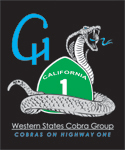 
 Main Menu
Main Menu
|
 Nevada Classics
Nevada Classics
|
 Advertise at CC
Advertise at CC
|
 December 2025
December 2025
|
| S |
M |
T |
W |
T |
F |
S |
| |
1 |
2 |
3 |
4 |
5 |
6 |
| 7 |
8 |
9 |
10 |
11 |
12 |
13 |
| 14 |
15 |
16 |
17 |
18 |
19 |
20 |
| 21 |
22 |
23 |
24 |
25 |
26 |
27 |
| 28 |
29 |
30 |
31 |
|
|
|
|
 CC Advertisers
CC Advertisers
|
|

09-28-2006, 03:28 PM
|
 |
CC Member

|
|
|
Join Date: Jul 2004
Location: Alpharetta,
GA
Cobra Make, Engine: ERA #414 427 s/o w. Shelby Aluminum heads, Edelbrock Performer RPM Intake, Mighty Demon 750, Tremec TKO 600
Posts: 714
|
|

 Not Ranked
Not Ranked
 Side-oiler mystery problem
Side-oiler mystery problem
I will first pre-face this thread by saying I'm not interested in mentioning names or finger pointing; just looking to leverage the collective knowledge for ideas and help.
I have a 427 side-oiler, C5AE-H block, with Shelby American Aluminum heads that have been mildly ported, and Edelbrock Performer RPM intake. Engine was freshly re-built 400 miles ago by a very reputable FE engine builder.
I ran the car hard one afternoon for about 90 minutes and then parked it. No noticable performance problems or missing. Next morning I pulled the #1-#4 plugs to get a reading from them. I noted the #2 plug was very white and clean. Given past history I feared it was from water in the cylinder. I turned the crank by hand and sure enough water shot out of #2 spark plug hole. It was a fair amount of water appearing to be enough to fill the cylinder.
I then removed the intake and valve train and filled the water jackets on the head as high as possible to see if there were any obvious leaks into the intake or exhaust ports on the head. Nothing obvious spoted.
I then ran a leak down test on #2 with cylinder head at TDC - leak down passed. I then ran it again, with the cylinder head at bottom of the stroke and got air bubbles appearing in the water jacket openings.
After discussion and debate, I pulled the engine and took it to a very reputable local FE shop to get repaired. They pressure checked the heads and the block with the engine still assembled and both passed.
Then decided to dis-assemble the short block, clean and magnaflux, do all the surface checks, etc and further pressure test the water jacket with 75 PSI. Still no indicator of leaks or issues. Only speculation at this point is potential for leaks via the head bolt holes via cracks in the bottom of those hole castings that protrude into the water jacket.
Next step is to re-assemble, swap the heads to opposite sides, use sealant on head bolts, and ensure good head and intake gasket seal, then put it on the dyno and see what happens under some hard runs.
So, am just hoping that maybe someone has seen this mystery before or has a tip that might help explain it. If I try to just think of the basic paths water could take to enter the block, and the fact that the block and heads appear ok, then I'm lead back to the head gaskets, with perhaps a nuance as follows. It has something to do with aluminum heads on an iron block and when it gets hot, there is some type of expansion that causes the gasket to leak. Thus, the water leaks in when the block and head are hottest ie after shutting off the engine when it's heat sinking with no coolant running through the engine. When it's cool, it all seals back up.
Appreciate your help and thoughts in the great side-oiler mystery!
Thanks!
Scott

|
-
Advertising


09-28-2006, 03:40 PM
|
|
CC Member

|
|
|
Join Date: Mar 2003
Cobra Make, Engine:
Posts: 1,515
|
|

 Not Ranked
Not Ranked
NO, no, no, no - say it ain't so! I'm already tired and the madness hasn't even begun.  |

09-28-2006, 06:26 PM
|
 |
CC Member

|
|
|
Join Date: Jul 2005
Location: Virginia Beach, Va & Port Charlotte, Fl.,
Posts: 2,292
|
|

 Not Ranked
Not Ranked

What bothers me is that the bubbles only showed up when the piston was at bottom dead center, not when it was at TDC. To me that would rule out a head gasket or head leak. It would point toward the lower half of that cylinder wall. The potential for cylinder wall distortion, given the "typical" thin cylinder wall history of rebuilt "OEM" 427s, is the greatest when the cylinder head is mounted and torqued to specs. That could be the reason it's not showing up under presurre and magnaflux testing with a "bare block".
That being said my recommendation is as follows..
If you didn't do it before I'd have that cylinder wall sonic tested for wall thickness. If it's too thin then I'd proceed to check the rest of the block to determine reusability. If it's OK then I'd have them bolt up a FE specific torque plate and torque to specs. At that time I'd have them do a die penetrant check, pressure test and magnaflux, in that order.
I can't remember if you talked about your block's history..but that would be my focus given the information you provided.
Dave
__________________
Too many toys?? never!
|

09-28-2006, 07:22 PM
|
 |
CC Member

|
|
|
Join Date: Feb 2006
Location: Gore. New Zealand.,
SI
Cobra Make, Engine: DIY Coupe, F/T ,MkIV.
Posts: 808
|
|

 Not Ranked
Not Ranked
When you did the leakdown with piston @ bdc you would have had 100 psi in the cyl and therefore tended to open up any flaws by expansion. When the guys in the shop pressure tested the water jackets it would tend to close off flaws etc by compression. Sonic test will give you a better idea if the block is worth saving.
Jac Mac
|

09-28-2006, 07:55 PM
|
|
CC Member

|
|
|
Join Date: May 2006
Location: St. Louisville,
Oh
Cobra Make, Engine: A&C 67 427 cobra SB
Posts: 2,445
|
|

 Not Ranked
Not Ranked

Quote:
|
Originally Posted by HSSS427
I then removed the intake and valve train and filled the water jackets on the head as high as possible to see if there were any obvious leaks into the intake or exhaust ports on the head. Nothing obvious spoted.
I then ran a leak down test on #2 with cylinder head at TDC - leak down passed. I then ran it again, with the cylinder head at bottom of the stroke and got air bubbles appearing in the water jacket openings.
|
This tells it all. Valves closed by no valve train. Air from cylinder gets into water jacket when piston is BDC, but not when piston is TDC. The problem is not the head or head gasket or it would do it TDC as well. The only explanation is that the piston at TDC is covering and sealing the leak. This means that the cylinder wall is cracked into the water jacket some where bellow TDC.
Too bad you didn't start with piston at TDC and slowly move it down until the bubbles were seen. This would have told you exactly where to look in the bore. Keep checking that bore. There has to be a crack or pin hole somewhere.

|

09-28-2006, 09:06 PM
|
 |
CC Member

|
|
|
Join Date: Jul 2004
Location: Alpharetta,
GA
Cobra Make, Engine: ERA #414 427 s/o w. Shelby Aluminum heads, Edelbrock Performer RPM Intake, Mighty Demon 750, Tremec TKO 600
Posts: 714
|
|

 Not Ranked
Not Ranked
What was I thinking....that's why I ruled out head gasket originally...duhhh.
So it's got to be the lower part of the cylinder. Tests to date have been done with a torque plate installed. They did do magnaflux and not sure on the dye test. Will mention the sonic and dye tests as I want to do everything I can before putting it back together. BTW, the cylinders on the affected side are sleeved, so wondering what the implications are toward the idea of the wall being too thin. I assuming the sleeves would address that, and the engine was already .030 overbore and that wasn't changed in the rebuild.
Thanks!
Last edited by HSSS427; 09-28-2006 at 09:13 PM..
|

09-30-2006, 01:42 PM
|
 |
CC Member

|
|
|
Join Date: Jun 2000
Location: Cape Town, South Africa/Mainz, Germany,
Posts: 1,601
|
|

 Not Ranked
Not Ranked
good day,
I once had an engine where the valve seat had a crack leaking water.
as long as the valve was closed the crack was sealed.
dominik
__________________
If I don't respond anymore, that's because I can't log in
|

09-30-2006, 03:19 PM
|
 |
CC Member

|
|
|
Join Date: Feb 2006
Location: Gore. New Zealand.,
SI
Cobra Make, Engine: DIY Coupe, F/T ,MkIV.
Posts: 808
|
|

 Not Ranked
Not Ranked
Its not common, but sleeves being cast can have imperfections or porosity which may be your problem here. I would fill the block waterjackets, recheck with the piston@ BDC and seal the cyl at the top with a piece of scrap 1/2" flat plate drilled for the 4 head bolts and an airline fitting. This would eliminate all the other variables like valve seats, head gaskets, etc. The leak may be thru the sleeve then have track around the sleeve to find the area in the original cyl bore that is weak or damaged to escape into the water jacket.
When your finished with it dont throw the plate away, going by the number of similar problems with big bore FE blocks on this forum you may get rich hiring the test plate to others!
Jac Mac
|

09-30-2006, 04:39 PM
|
 |
Senior Club Cobra Member

|
|
|
Join Date: Nov 1999
Location: Folsom,
CA
Cobra Make, Engine: ERA 623, 427 S/C Cobra. Ford FE 428 Cobra Jet, Ford Nascar TL 4speed - with a touch of raw; "less is more" theme
Posts: 3,887
|
|

 Not Ranked
Not Ranked
A local guy near me had the same type of problem with water getting in; it only occured once the motor got warmed up real good. It was on a known/salvaged 427. It had a single cylinder on a block that was sleeved and he went through 4 seperate attempts on that block to fix it until they finally "pinned" the impacted cylinder somehow and resleeved it for a 4th time. Based on what I saw him go through, it would not seem prudent to put yours back together until you are absolutely sure what's cracked or if its worth saving; hopefully it can be fixed right the first time. Good Luck. 
__________________
Duane
Western States Cobra Group 1998-2016.
|

09-30-2006, 04:54 PM
|
|
Senior Club Cobra Member

|
|
|
Join Date: Jul 2002
Cobra Make, Engine:
Posts: 15,712
|
|

 Not Ranked
Not Ranked
Whew, multiple water leaks in the alloy heads, you had them off and on and made various repairs. I guess you finally fixed those problems? Now more water from a different area, the block this time? Darn, it doesn't reflect well on the builder, no matter how it gets resolved (assuming it does) at this point...
Last edited by Excaliber; 09-30-2006 at 05:00 PM..
|

10-01-2006, 07:55 PM
|
|
CC Member

|
|
|
Join Date: May 2006
Location: St. Louisville,
Oh
Cobra Make, Engine: A&C 67 427 cobra SB
Posts: 2,445
|
|

 Not Ranked
Not Ranked

The more I thought about this, it makes sense. Water will only leak into the cylinder when it sits with the piston down. Depending how far down, it may be rare that the engine stops with the piston in a spot where it can leak.
The tests that were done, like magnaflux are good for finding a crack, but they may not do well at finding a tiny pin hole.
Another thought occurred to me, after you said this cylinder has been sleeved. Assuming the sleeve should be dry - no water touching the outside of the sleeve wall. Then there would have to be a hole in the sleeve that mates up to a hole in the blocks cylinder wall. What are the odds that this would happen? Not likely. However, why was it sleeved in the first place. The cylinder wall in the block may have had a big crack.
There could be a water leak between the sleeve and block. If the sleeve is not a tight enough fit, water will leak between the sleeve and cylinder wall of the block. It could go up into the head gasket area and flow over into the combustion chamber. If the sleeve is of a metal that has a different coefecient (SP) of thermal expansion than that of the block, the tightness of this fit will change with temperature.
This does not explain why it would leak at BDC but not TDC. The only thing I could think of is that the force of the rings pushing out on the sleeve was enough to seal it. Seems like a weak theory, but possible.
See if there is a way to seal up the block, yet still be able to see where the sleeve meets the block at the head deck. Pressure the block with air and put soapy water around the sleeve where it meets the block and in the bore. Look for bubbles. May not be possible, but with enough will power it may be done.

|

10-01-2006, 08:06 PM
|
|
Senior Club Cobra Member

|
|
|
Join Date: Jul 2002
Cobra Make, Engine:
Posts: 15,712
|
|

 Not Ranked
Not Ranked
"Bars-Leak", yeah, THATS the ticket! 
Gessford has an interesting writeup about how they install sleeves in a side oiler. Tricky stuff that, they use liquid nitrogen at some point, to shrink the sleeve itself I guess. As side oilers are 'thin wall' all ready and cannot be bored very much sleeving one is somewhat common. Doing it RIGHT, may not be so common! Some side oiler blocks have a thin wall bore that needs sleeving right out of the box! So the block doesn't have to have been 'broke' to require sleeving. |

10-01-2006, 08:55 PM
|
|
CC Member

|
|
|
Join Date: May 2006
Location: St. Louisville,
Oh
Cobra Make, Engine: A&C 67 427 cobra SB
Posts: 2,445
|
|

 Not Ranked
Not Ranked
Quote:
|
Originally Posted by Excaliber
"Bars-Leak", yeah, THATS the ticket! 
Gessford has an interesting writeup about how they install sleeves in a side oiler. Tricky stuff that, they use liquid nitrogen at some point, to shrink the sleeve itself I guess. As side oilers are 'thin wall' all ready and cannot be bored very much sleeving one is somewhat common. Doing it RIGHT, may not be so common! Some side oiler blocks have a thin wall bore that needs sleeving right out of the box! So the block doesn't have to have been 'broke' to require sleeving. |
Wonder how this particular block was sleeved? Even if they are tight, a scratch in either the block bore or the outer sleeve wall would allow a leak path, if the block is leaking water into that area. |

10-01-2006, 11:42 PM
|
 |
CC Member

|
|
|
Join Date: Jun 2000
Location: Cape Town, South Africa/Mainz, Germany,
Posts: 1,601
|
|

 Not Ranked
Not Ranked
okay,
I admit I did not get the part with the valve train removed, meaning the valves werde closed.
So my theory of a leaking valve seat doesn't hold any value.
Is there also water in the oil?
dominik
__________________
If I don't respond anymore, that's because I can't log in
|

10-01-2006, 11:56 PM
|
|
Senior Club Cobra Member

|
|
|
Join Date: Jul 2002
Cobra Make, Engine:
Posts: 15,712
|
|

 Not Ranked
Not Ranked
I wonder how the technique might vary from one builder to another, or is it pretty much done the same way by all of them? How long ago was THIS blocked sleeved and what technique was used?
|

10-02-2006, 08:29 PM
|
 |
CC Member

|
|
|
Join Date: Jul 2004
Location: Alpharetta,
GA
Cobra Make, Engine: ERA #414 427 s/o w. Shelby Aluminum heads, Edelbrock Performer RPM Intake, Mighty Demon 750, Tremec TKO 600
Posts: 714
|
|

 Not Ranked
Not Ranked
Problem is I don't know much about the original engine as it was in the car when I bought it. It was built circa 1996 near Sonoma Valley CA. So, it had about 6000 miles on it with the sleeve in it and no known problems. So this is something since the re-build that has happened to it.
Also, no noticable water in the oil - I pulled the drain plug and let it run for a bit and later drained it all, and no light brown sludge in it.
I think I'm going to ask what it would cost to re-sleeve #2 while the block is apart "just to be sure" if we can't find anything else. Also thinking about putting some block filler in the bottom and some kind of block sealer that finds the cracks. |

10-03-2006, 06:37 AM
|
 |
CC Member

|
|
|
Join Date: Dec 2000
Location: Broken Arrow. OK ( South Tulsa), USA,
OK
Cobra Make, Engine: 66 COBRA FE 427 /4SP. (HCS Coupe w/ 408 Stroker and TKO 600 -sold)
Posts: 5,595
|
|

 Not Ranked
Not Ranked
I think a resleave will cost you about $100 + for the sleve which is pretty cheap given all the work you have been through. By the way all engine builders do not use nitrogen to install sleves. Many machine out the cylinder leaving a step at the bottom of the cylinder for the new sleve to rest on and to keep it from being pushed or pulled down into the crank. Then the sleve is then pressed into the cylinder and machined to the piston.
I personally think you have an abnomally with that cylinder and a sleve might be a good, quick, and fairly inexpensive fix.
Good luck with your investigation.
Clois
__________________
Sunshine, Asphalt and no stop signs...Perfect
"Let's roll"
"Be part of Something Good
......Leave Something Good Behind!"
from CD "Long Road Out of Eden"
|

10-03-2006, 09:32 AM
|
 |
CC Member

|
|
|
Join Date: Jun 2000
Location: Cape Town, South Africa/Mainz, Germany,
Posts: 1,601
|
|

 Not Ranked
Not Ranked
hi!
they probably also have to deck the block.
make sure they put the cylinder head dowel pins back!
dominik
__________________
If I don't respond anymore, that's because I can't log in
|

10-03-2006, 09:59 AM
|
 |
CC Member

|
|
|
Join Date: Jul 2004
Location: Alpharetta,
GA
Cobra Make, Engine: ERA #414 427 s/o w. Shelby Aluminum heads, Edelbrock Performer RPM Intake, Mighty Demon 750, Tremec TKO 600
Posts: 714
|
|

 Not Ranked
Not Ranked
Talked to the shop today, and a couple of notes:
- They are decking the block and honing the cylinders - the guys said that often during honeing any cracks or issues in the cylinder wall will show up
- He said they did magnaflux the block but that it is difficult to get a good evaluation of the cylinder walls as you can't get the magnaflux to stick very well to the cylinder wall. He also said a split cylinder sleeve may not show up on a maganflux.
- Decided to go ahead and re-sleeve that cylinder as it's cheap insurance. He said they'd also get a good look to find any cracks when they machined out the old sleeve
Hopefully this work will reveal the original issue.
Thanks!
|

10-03-2006, 10:03 AM
|
|
Senior Club Cobra Member

|
|
|
Join Date: Jul 2002
Cobra Make, Engine:
Posts: 15,712
|
|

 Not Ranked
Not Ranked
If Gessford uses nitrogen, something tells me that is the best way to do it. Consider this: I can't recall a SINGLE thread or post or comment related to a 'problem' with any of Gessfords work, ever. Maybe I've just missed such a comment, if it exists? I mean, surely you can't keep ALL the people happy ALL the time? Or can you...  |
 Posting Rules
Posting Rules
|
You may not post new threads
You may not post replies
You may not post attachments
You may not edit your posts
HTML code is Off
|
|
|
All times are GMT -7. The time now is 09:08 PM.
|






















 Linear Mode
Linear Mode



